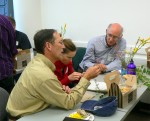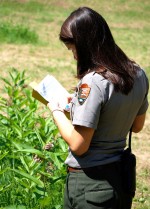A National Observation and Information Management Network for Phenology
If you headed outside this fall you might have seen maple leaves turning to their late season colors, osprey migrating south and bucks locking antlers. These recurring plant and animal life stages are called “phenology”, and information on the timing of these seasonal events is important to recreation, agriculture, natural resource management, health, and conservation. Phenology can help answer questions such as why organisms occur in a particular place, what affects the growth and development of particular species, and how a changing climate might impact these species.
The USA National Phenology Network (USA-NPN; www.usanpn.org) was created as a collaborative network of government agencies, nongovernmental organizations, citizen science and education programs, as well as individual researchers and citizen scientists, to make long-term phenology data sets accessible to scientists and resource managers. With this goal in mind, the USA-NPN National Coordinating Office (NCO) has developed standardized monitoring protocols and an Information Management System (IMS) to facilitate collaboration and participatory data collection and digitization. The IMS includes components for data storage, such as the National Phenology Database, as well as a website built using the open-source Drupal content management platform for information-sharing and data visualization, and a Java application for collection of contemporary observational data. The system was reviewed in July 2010 by experts in the field, among them Inigo San Gil, a USA-NPN board member and the liaison between the Long Term Ecological Research (LTER) Network and the National Biological Information Infrastructure (NBII).
To help people across the nation track phenology with observations of plants and animals in their own backyards, the USA-NPN NCO has developed a plant and animal phenology observation program called Nature’s Notebook. Since going live in March 2009, the program has registered 2,300 observers and submitted over 40,000 observations on 300 plant and 60 animal species to the National Phenology Database. However, some of our most committed observers are participating through partner organizations, such as the University of California-Santa Barbara’s Phenology Stewardship Program, the Arbor Day Foundation, and the Great Sunflower Project.
LTER is closely involved with the USA-NPN, whose NCO and several LTER sites, including Jornada Basin and Hubbard Brook, are currently working to develop and implement methodologies and tools to cross-walk historical data with newly-developed, standardized protocols for monitoring phenology. In fact, researchers at Cedar Creek LTER in Minnesota are currently the top contributors to Nature’s Notebook, with over 3,000 observations submitted. Additionally, during the 2009 LTER All Scientists Meeting at Estes Park, CO, interested scientists convened a working group on phenology and held a workshop to assess the level of interest and acquire LTER site level input. Visit www.usanpn.org/lter to view the working group report.
The upcoming year is likely to see stepped up observer recruitment efforts, the addition of intensity and abundance measures to our protocols, a prototype smartphone application, and web services for data input and output.
If you would like to participate as a partner organization, we invite you to explore the partners’ area of our website (www.usanpn.org/participate/new-partners) or contact us for more information at partners@usanpn.org. If, instead, you prefer to participate as an individual, becoming an observer is easy: visit www.usanpn.org/how-observe to learn about the plants and animals that you can observe and how to observe, and then sign up and start reporting!

 Enlarge this image
Enlarge this image
